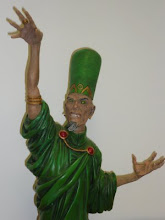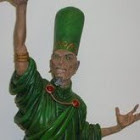 Stupendous art drives a thoughtful story with outsize monsters trampling the world to bits as they fight each other and humanity are just, squashed bystanders. James Stokoe takes a very familiar story, the monster born from the atomic bomb dropped on Japan and creates a griping and unexpected story. In 1954 Ota Murakami encounters Godzilla when he first emerges to tear up Tokyo and this marks the start of a 50 year struggle with the monster. Across the decades the struggles takes place in different locations and the escalation in the struggle is both cleverly explained as is the developing relationship Ota feels with Godzilla. The climax is fitting and suitably explosive.
Stupendous art drives a thoughtful story with outsize monsters trampling the world to bits as they fight each other and humanity are just, squashed bystanders. James Stokoe takes a very familiar story, the monster born from the atomic bomb dropped on Japan and creates a griping and unexpected story. In 1954 Ota Murakami encounters Godzilla when he first emerges to tear up Tokyo and this marks the start of a 50 year struggle with the monster. Across the decades the struggles takes place in different locations and the escalation in the struggle is both cleverly explained as is the developing relationship Ota feels with Godzilla. The climax is fitting and suitably explosive.The simply astonishing art and vibrant colouring are nearly overwhelming, James Steokoe manages to get a number of critical elements just right. The first is the distinctly magna feel to the art, this is a Japanese story at its heart and the art acknowledges this without every being subservient to it. The cast have the expressive emotions and wonderful technology that magna can deliver so well, along with the astounding level of detail that anchors the story in a physical world.
When dealing with Godzilla there is always a problem of scale to be solved, to give Godzilla its due means that the human cast would have to be insignificant, the art manages to balance both giving the monsters the size and the humans the room they need to interact in a meaningful way. The range of monsters is great and the tremendous destructive force of their encounters is superbly delivered.
Probably the most important element that is right is that this is not a story about Godzilla, despite the title. This is the story of Ota Murakami and his entirely one sided relationship with the utterly unknowable Godzilla. By keeping the story focus on Ota James Stokoe solves a crucial problem, how to sustain a story about a monster that cannot communicate in any way with humanity other than through rampaging destruction. There is very little scope to drive a story forward no matter how creatively destruction is displayed.
The colouring in the comic is as vibrant and detailed as the art it lifts and celebrates. The colouring is used to draw attention, add feeling and create a vital extra layer to the story, it provides an strong and effective emotional context for what is going on all around the cast. It never hides the details, it gives them room to be seen without being overwhelmed.
The passage of time is carefully captured and very effectively used as Ota grows old in this war and the space for humanity steadily gets less and less. The shattering consequences are captured by the aging Ota as he reaches a final accommodation with a creature who has stolen his life and his world. The move from anger to reluctant acceptance of the real impact of Godzilla on his life is he core of the book and it gives it a grip every bit as powerful as one of Godzilla's claws. A great comic that finds room for the humans amongst the feet of monsters.


No comments:
Post a Comment